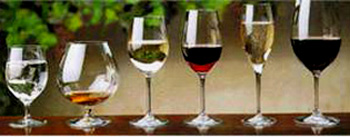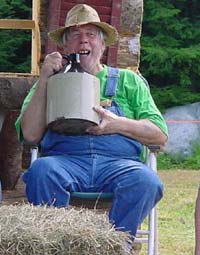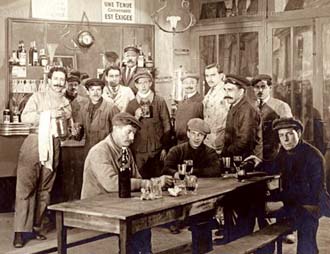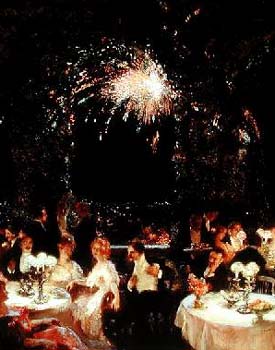 |
Formation of Children
Chapter 28 - Other Essential Table Manners
Marian T. Horvat, Ph.D.
In the previous chapter on table manners, the young man learned how to seat himself at the table, the proper utensils to use, and how to hold them.
Table customs differ with every country and epoch. Nonetheless, there are some general rules that are observed everywhere. Below we offer some other rules applicable to all times and places.
At a restaurant or club, if a plate is not satisfactory, you may request the waiter to change it once. If the dish does not please you the second time, do not ask for another replacement. Just remember not to ask for that dish again in the future, or avoid eating at that particular place.
One should not blow on the soup when it is very hot, but should stir it moderately with the spoon. Fill your soup spoon by placing it in the bowl and moving it away from you. You may tilt your bowl away from you to get the last bits of soup, but only do it twice.

Each drink in its proper vessel: from left to right, glasses for water, brandy, white wine, pinor noir, champagne, and red wine |
The hillbilly keeps hold of his fork; the educated man uses it only to bring the food to his mouth, and then lets it rest on the plate. Remember proper table manners forbid placing a used eating utensil back on the table, where it could soil the tablecloth.
Meats with bones, such as chicken or ribs, can cause difficulty at times. It is not advisable to use your fingers to eat them. One should remove as much meat as possible from them with the knife and fork, and set the bones on one side of the plate, avoiding letting any bones or bits fall on the tablecloth or floor.

A hillbilly drinking straight from the jug... |
The best and safest procedure to follow at the table is to never use your fingers. Exceptions to this rule are grapes, cherries, tangerines or the like served as a dessert or appetizer. In this case, the host should provide a small water bowl for each guest or a wet napkin to clean the fingers.
Difficult food to pick up with the fork, such as peas, can be pushed onto the fork either by the knife or a piece of bread broken off for this purpose. Do not use your fingers.
In the United States, certain foods, such as corn on the cob, spareribs, chicken, sandwiches, and certain fruits are often eaten with the fingers at the table. In Europe and South America, this is not acceptable. In their fine restaurants, the American is always spotted by these less gracious eating habits. It is advisable to follow the more refined customs developed by Christian Civilization, and make the good habit in our homes to exercise the discipline of not using the fingers to eat, but rather the proper utensils.
Some other good customs
Good manners prohibit smashing the vegetables on the plate. Except in very familiar company, no one should wipe the plate with bread to absorb the gravy. Even at the family table, children should learn not to do this. Instead, pieces of bread can be put on the plate to take up the gravy, and raised to the mouth with the fork. Gravy should never be eaten with a spoon. The same rules apply to poached or over-easy eggs. Unless you are among close friends or relatives, do not dip your bread into the yolk or smash your egg with the fork. At the family table, you may dip a piece of bread into the yolk and raise it to the mouth, taking care not to spill it on your suit or tie.

In a simple French cafe of the 1930s,
drinks are served in proper glasses |
Proper etiquette says you should cut only the piece of meat or food that you plan to eat. Do not cut your food up all at one time, unless you are about to feed a baby. Also, it is not advisable for a person to play with his food, arranging and re-arranging it on the plate between bites.
One should eat the salad with the proper fork, taking care not to let pieces escape from the edges of the plate. Use the salad fork, and not a knife, to cut the lettuce. This practice may appear insignificant, but really spotlights a polished person. The considerate host who knows this rule will take care to serve a salad that is manageable with a fork.
Break off small pieces of bread into bite size pieces with the fingers, and not with the knife. Take a portion of butter from the butter dish with your butter knife and place it onto your bread plate. Butter your bread a piece at a time, not the whole slice at once. Use the butter that you have placed on your butter plate, not that from the common butter plate on the table
Elementary etiquette demands that you always keep your mouth closed while you chew and do not make loud noises while eating. It's acceptable to talk with a small piece of food in your mouth, but do not attempt it if your mouth is full or close to it.
Always use a napkin to remove leftovers of food from your lips,
The pits of olives, prunes, or any other fruits should be set at the side of the plate. To remove the pit, the general rule is to take it out the same way it went in. So, if you ate the cherry with your fingers, you can remove the pit with your fingers as well, but do so as discreetly as possible. A tasteful way to retrieve a pit is to cup the free hand, then transfer the pit from the mouth to the cupped hand. Open the hand to place the pit on the plate. If you eat an olive in the salad with your fork, deposit the pit on the fork as unobtrusively as possible to return it to the plate.

Good tables manners are essential at gala parties |
After removing the skin and seeds, cut an apple or pear into smaller parts and raise them to the mouth with the fork, not with the fingers. A well-bred man cuts his apple or pear from top to bottom, not from side to side. Oranges are eaten in various ways. The most refined way is to peel the fruit with a fruit knife and fork, cut it into quarters or wedges, and raise them to the mouth with a fork. You can view a video of how to cut an orange with a knife and fork here.
At the table, never clean your teeth with your fingers. It is permissible to cover the mouth with one hand, avert the face slightly, and remove the food with a toothpick as inconspicuously as possible. A sure sign of a hillbilly is the person who leaves the table or restaurant with a toothpick hanging out of his mouth.
These rules and many others that should govern table habits are not arbitrary. They are the fruit of experience, and their objective is the well-being, pleasure, and dignity of everyone at the table, and to maintain the best order in clothing and utensils.
Drinks and coffee
The aperitif, from the Latin aperire, is a wine or alcoholic drink to open the appetite. Vermouth, sherry, port, or a light wine are often served before a meal, usually with a light appetizer such as crackers or olives. A tomato juice “cocktail” is a nonalcoholic drink that is also commonly served as an aperitif. Europeans also serve a digestif after meals, which is usually a strong dry spirit for men and liqueur for women. Port or Sherry may also be served after meals.
All drinks should be served in an appropriate vessel. Never drink water, beer, or a soft drink from a bottle or can, ask for a glass.

The toast! |
When pouring wine, beer or any other drink, it is proper to hold the bottle by the higher part, rather than the lower.
It is necessary to accustom children to drink silently, without making slurping or other sounds. One should drink slowly and never when one has food in the mouth.
At company meals, the toast should be simple and short, joyful, and good humored. At such meals the guest waits until the toast is made before beginning to drink from his wine or champagne glass. At banquets or ceremonial dinners, the toast is made at the beginning of the dessert, the right hand slightly raised. Traditionally, at a formal dinner the host or hostess offers the first toast. If a speech is delivered, it should be made during the dessert. This is a polite way to insinuate that it should be short, since both the homage and the thank-you responses should not take longer than the dessert. The toasting glass should be only half-filled at maximum. The toast should always be responded to. A speech does not require any response from the guest of honor except a simple “Thank you.”
Physical nourishment may be accompanied by a spiritual refreshment. In religious communities, a public reading from edifying works during meals ennobles the meal activity. In the family home, calm, unpretentious, and pleasant conversation will make the meal into a human act, and not just feeding the body its required nutrients. It is a lack of civility to watch television or read papers or books when dining with others at the table.
Finally, no one should forget that sobriety and moderation protects the health of body and soul. The wise man is the temperate man who lives a longer and better life. To know how to live is a requisite for living long, harmonic years.
The Shah and the asparagus
At times it is necessary to exercise presence of mind to help a neighbor and prevent him from some public infraction of basic table manners. When a foreigner or one new to our customs is lost in the confusion of an invincible ignorance, it is charitable to help him or to take a measure to save him from some humiliation. Here is a case like this.
In 1873 the Prince of Wales, the future Edward VII, King of England, invited the Shah of Persia to lunch in London with a group of notable personalities. The Shah was not accustomed to European habits. When he was served a plate of asparagus with a savory sauce, he picked up a piece between his fingers, dipped it in the sauce, tilted his head back, lowered the asparagus into it, and sucked off the outer layer and sauce. Then, with the greatest naturality in the world, he threw the remainder to the side of the chair.
There was a silent but general stupefaction at the table.
The Prince of Wales, without a moment of hesitation, did the same. Then all the guests imitated him. The servants did not know where such an unexpected bombardment of asparagus stems came from!

Posted March 5, 2008


Related Topics of Interest
 Eating Alone Eating Alone
 Fast Food Is Protestant Fast Food Is Protestant
 Manners Make Life Easier Manners Make Life Easier
 Courtesy in the Catholic Home Courtesy in the Catholic Home
 Chapter 18: Let's Not Forget the Greeting Chapter 18: Let's Not Forget the Greeting
 Chapter 19: The Blessing Chapter 19: The Blessing
 Chapter 20: The Family Milieu Chapter 20: The Family Milieu
 Chapter 21: A Youth's Relations with His Superiors Chapter 21: A Youth's Relations with His Superiors
 Proper Behavior for Visits - Part I Proper Behavior for Visits - Part I

Related Works of Interest
|
|
Formation | Cultural | Home | Books | CDs | Search | Contact Us | Donate

© 2002- Tradition in Action, Inc. All Rights Reserved
|
 |
|